Qinghua Lu
IEEE Fellow
MARIA: A Framework for Marginal Risk Assessment without Ground Truth in AI Systems
Oct 31, 2025Abstract:Before deploying an AI system to replace an existing process, it must be compared with the incumbent to ensure improvement without added risk. Traditional evaluation relies on ground truth for both systems, but this is often unavailable due to delayed or unknowable outcomes, high costs, or incomplete data, especially for long-standing systems deemed safe by convention. The more practical solution is not to compute absolute risk but the difference between systems. We therefore propose a marginal risk assessment framework, that avoids dependence on ground truth or absolute risk. It emphasizes three kinds of relative evaluation methodology, including predictability, capability and interaction dominance. By shifting focus from absolute to relative evaluation, our approach equips software teams with actionable guidance: identifying where AI enhances outcomes, where it introduces new risks, and how to adopt such systems responsibly.
Bi-level Personalization for Federated Foundation Models: A Task-vector Aggregation Approach
Sep 16, 2025Abstract:Federated foundation models represent a new paradigm to jointly fine-tune pre-trained foundation models across clients. It is still a challenge to fine-tune foundation models for a small group of new users or specialized scenarios, which typically involve limited data compared to the large-scale data used in pre-training. In this context, the trade-off between personalization and federation becomes more sensitive. To tackle these, we proposed a bi-level personalization framework for federated fine-tuning on foundation models. Specifically, we conduct personalized fine-tuning on the client-level using its private data, and then conduct a personalized aggregation on the server-level using similar users measured by client-specific task vectors. Given the personalization information gained from client-level fine-tuning, the server-level personalized aggregation can gain group-wise personalization information while mitigating the disturbance of irrelevant or interest-conflict clients with non-IID data. The effectiveness of the proposed algorithm has been demonstrated by extensive experimental analysis in benchmark datasets.
OASIS: Harnessing Diffusion Adversarial Network for Ocean Salinity Imputation using Sparse Drifter Trajectories
Aug 29, 2025Abstract:Ocean salinity plays a vital role in circulation, climate, and marine ecosystems, yet its measurement is often sparse, irregular, and noisy, especially in drifter-based datasets. Traditional approaches, such as remote sensing and optimal interpolation, rely on linearity and stationarity, and are limited by cloud cover, sensor drift, and low satellite revisit rates. While machine learning models offer flexibility, they often fail under severe sparsity and lack principled ways to incorporate physical covariates without specialized sensors. In this paper, we introduce the OceAn Salinity Imputation System (OASIS), a novel diffusion adversarial framework designed to address these challenges.
Reality Check: A New Evaluation Ecosystem Is Necessary to Understand AI's Real World Effects
May 24, 2025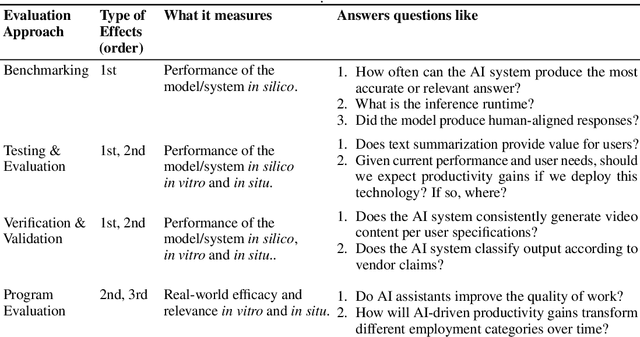
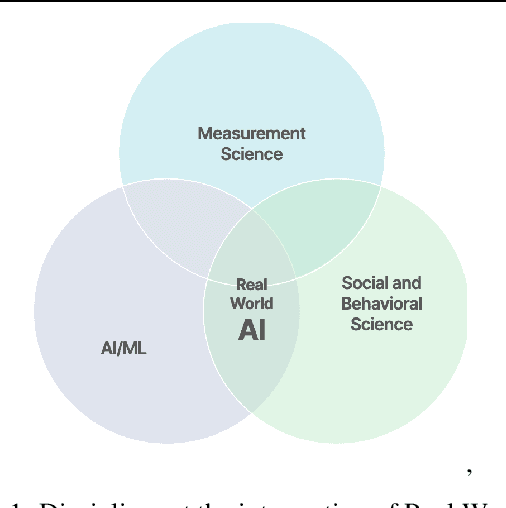

Abstract:Conventional AI evaluation approaches concentrated within the AI stack exhibit systemic limitations for exploring, navigating and resolving the human and societal factors that play out in real world deployment such as in education, finance, healthcare, and employment sectors. AI capability evaluations can capture detail about first-order effects, such as whether immediate system outputs are accurate, or contain toxic, biased or stereotypical content, but AI's second-order effects, i.e. any long-term outcomes and consequences that may result from AI use in the real world, have become a significant area of interest as the technology becomes embedded in our daily lives. These secondary effects can include shifts in user behavior, societal, cultural and economic ramifications, workforce transformations, and long-term downstream impacts that may result from a broad and growing set of risks. This position paper argues that measuring the indirect and secondary effects of AI will require expansion beyond static, single-turn approaches conducted in silico to include testing paradigms that can capture what actually materializes when people use AI technology in context. Specifically, we describe the need for data and methods that can facilitate contextual awareness and enable downstream interpretation and decision making about AI's secondary effects, and recommend requirements for a new ecosystem.
Federated Adapter on Foundation Models: An Out-Of-Distribution Approach
May 02, 2025Abstract:As foundation models gain prominence, Federated Foundation Models (FedFM) have emerged as a privacy-preserving approach to collaboratively fine-tune models in federated learning (FL) frameworks using distributed datasets across clients. A key challenge for FedFM, given the versatile nature of foundation models, is addressing out-of-distribution (OOD) generalization, where unseen tasks or clients may exhibit distribution shifts leading to suboptimal performance. Although numerous studies have explored OOD generalization in conventional FL, these methods are inadequate for FedFM due to the challenges posed by large parameter scales and increased data heterogeneity. To address these, we propose FedOA, which employs adapter-based parameter-efficient fine-tuning methods for efficacy and introduces personalized adapters with feature distance-based regularization to align distributions and guarantee OOD generalization for each client. Theoretically, we demonstrate that the conventional aggregated global model in FedFM inherently retains OOD generalization capabilities, and our proposed method enhances the personalized model's OOD generalization through regularization informed by the global model, with proven convergence under general non-convex settings. Empirically, the effectiveness of the proposed method is validated on benchmark datasets across various NLP tasks.
FactFlow: Automatic Fact Sheet Generation and Customization from Tabular Dataset via AI Chain Design & Implementation
Feb 25, 2025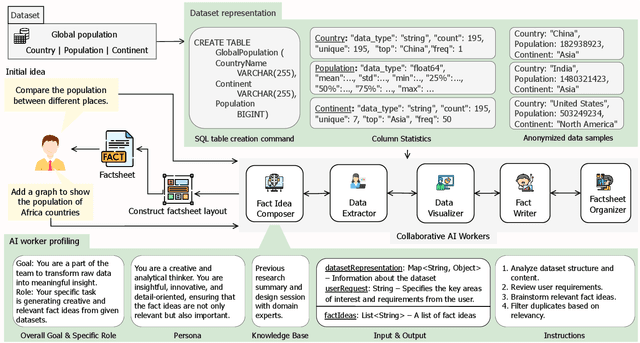
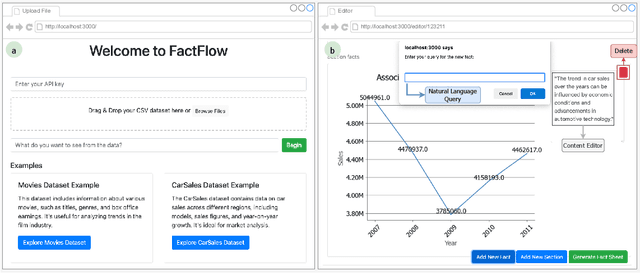
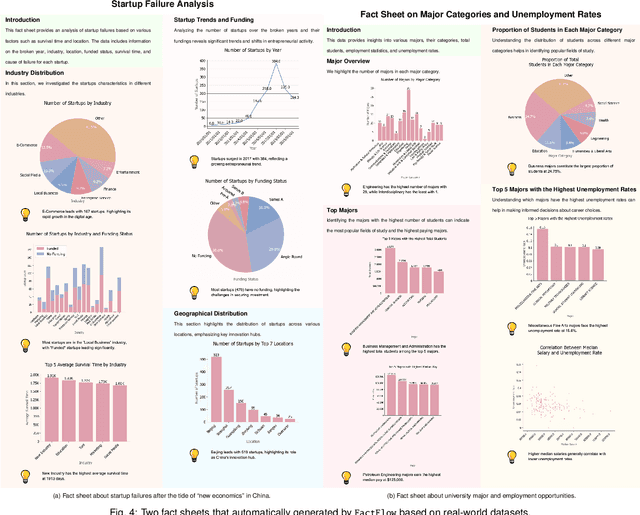

Abstract:With the proliferation of data across various domains, there is a critical demand for tools that enable non-experts to derive meaningful insights without deep data analysis skills. To address this need, existing automatic fact sheet generation tools offer heuristic-based solutions to extract facts and generate stories. However, they inadequately grasp the semantics of data and struggle to generate narratives that fully capture the semantics of the dataset or align the fact sheet with specific user needs. Addressing these shortcomings, this paper introduces \tool, a novel tool designed for the automatic generation and customisation of fact sheets. \tool applies the concept of collaborative AI workers to transform raw tabular dataset into comprehensive, visually compelling fact sheets. We define effective taxonomy to profile AI worker for specialised tasks. Furthermore, \tool empowers users to refine these fact sheets through intuitive natural language commands, ensuring the final outputs align closely with individual preferences and requirements. Our user evaluation with 18 participants confirms that \tool not only surpasses state-of-the-art baselines in automated fact sheet production but also provides a positive user experience during customization tasks.
Towards Advancing Code Generation with Large Language Models: A Research Roadmap
Jan 20, 2025Abstract:Recently, we have witnessed the rapid development of large language models, which have demonstrated excellent capabilities in the downstream task of code generation. However, despite their potential, LLM-based code generation still faces numerous technical and evaluation challenges, particularly when embedded in real-world development. In this paper, we present our vision for current research directions, and provide an in-depth analysis of existing studies on this task. We propose a six-layer vision framework that categorizes code generation process into distinct phases, namely Input Phase, Orchestration Phase, Development Phase, and Validation Phase. Additionally, we outline our vision workflow, which reflects on the currently prevalent frameworks. We systematically analyse the challenges faced by large language models, including those LLM-based agent frameworks, in code generation tasks. With these, we offer various perspectives and actionable recommendations in this area. Our aim is to provide guidelines for improving the reliability, robustness and usability of LLM-based code generation systems. Ultimately, this work seeks to address persistent challenges and to provide practical suggestions for a more pragmatic LLM-based solution for future code generation endeavors.
From Exploration to Revelation: Detecting Dark Patterns in Mobile Apps
Nov 27, 2024Abstract:Mobile apps are essential in daily life, yet they often employ dark patterns, such as visual tricks to highlight certain options or linguistic tactics to nag users into making purchases, to manipulate user behavior. Current research mainly uses manual methods to detect dark patterns, a process that is time-consuming and struggles to keep pace with continually updating and emerging apps. While some studies targeted at automated detection, they are constrained to static patterns and still necessitate manual app exploration. To bridge these gaps, we present AppRay, an innovative system that seamlessly blends task-oriented app exploration with automated dark pattern detection, reducing manual efforts. Our approach consists of two steps: First, we harness the commonsense knowledge of large language models for targeted app exploration, supplemented by traditional random exploration to capture a broader range of UI states. Second, we developed a static and dynamic dark pattern detector powered by a contrastive learning-based multi-label classifier and a rule-based refiner to perform detection. We contributed two datasets, AppRay-Dark and AppRay-Light, with 2,185 unique deceptive patterns (including 149 dynamic instances) across 18 types from 876 UIs and 871 benign UIs. These datasets cover both static and dynamic dark patterns while preserving UI relationships. Experimental results confirm that AppRay can efficiently explore the app and identify a wide range of dark patterns with great performance.
An Evaluation-Driven Approach to Designing LLM Agents: Process and Architecture
Nov 21, 2024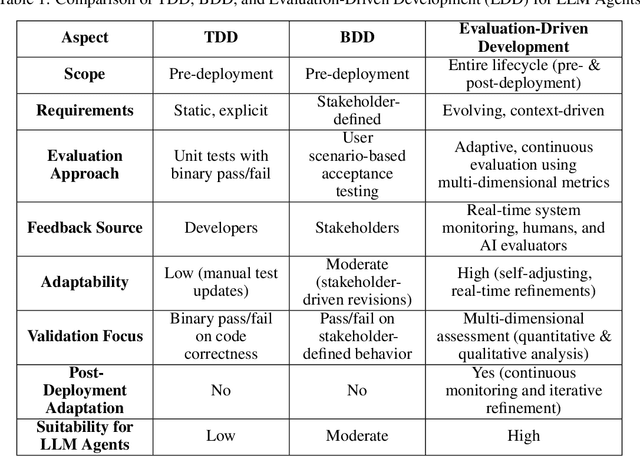

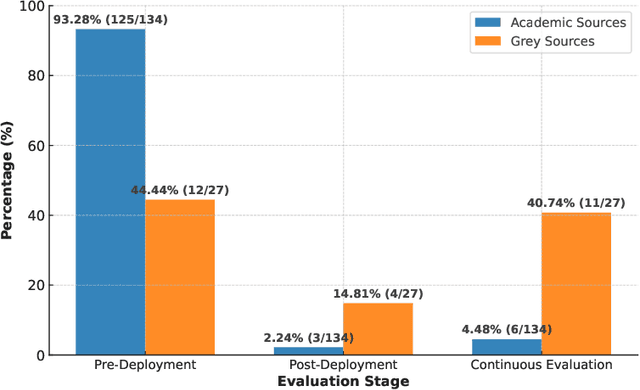

Abstract:The advent of Large Language Models (LLMs) has enabled the development of LLM agents capable of autonomously achieving under-specified goals and continuously evolving through post-deployment improvement, sometimes without requiring code or model updates. Conventional approaches, such as pre-defined test cases and code/model redevelopment pipelines, are inadequate for addressing the unique challenges of LLM agent development, particularly in terms of quality and risk control. This paper introduces an evaluation-driven design approach, inspired by test-driven development, to address these challenges. Through a multivocal literature review (MLR), we synthesize existing LLM evaluation methods and propose a novel process model and reference architecture specifically designed for LLM agents. The proposed approach integrates online and offline evaluations to support adaptive runtime adjustments and systematic offline redevelopment, improving runtime pipelines, artifacts, system architecture, and LLMs by continuously incorporating evaluation results, including fine-grained feedback from human and AI evaluators.
A Taxonomy of AgentOps for Enabling Observability of Foundation Model based Agents
Nov 08, 2024



Abstract:The ever-improving quality of LLMs has fueled the growth of a diverse range of downstream tasks, leading to an increased demand for AI automation and a burgeoning interest in developing foundation model (FM)-based autonomous agents. As AI agent systems tackle more complex tasks and evolve, they involve a wider range of stakeholders, including agent users, agentic system developers and deployers, and AI model developers. These systems also integrate multiple components such as AI agent workflows, RAG pipelines, prompt management, agent capabilities, and observability features. In this case, obtaining reliable outputs and answers from these agents remains challenging, necessitating a dependable execution process and end-to-end observability solutions. To build reliable AI agents and LLM applications, it is essential to shift towards designing AgentOps platforms that ensure observability and traceability across the entire development-to-production life-cycle. To this end, we conducted a rapid review and identified relevant AgentOps tools from the agentic ecosystem. Based on this review, we provide an overview of the essential features of AgentOps and propose a comprehensive overview of observability data/traceable artifacts across the agent production life-cycle. Our findings provide a systematic overview of the current AgentOps landscape, emphasizing the critical role of observability/traceability in enhancing the reliability of autonomous agent systems.
 Add to Chrome
Add to Chrome Add to Firefox
Add to Firefox Add to Edge
Add to Edge